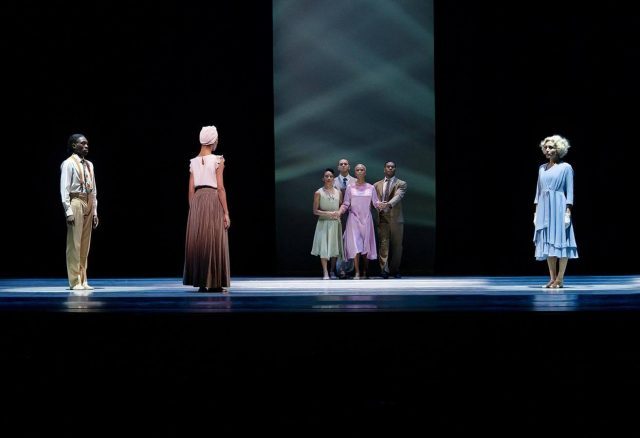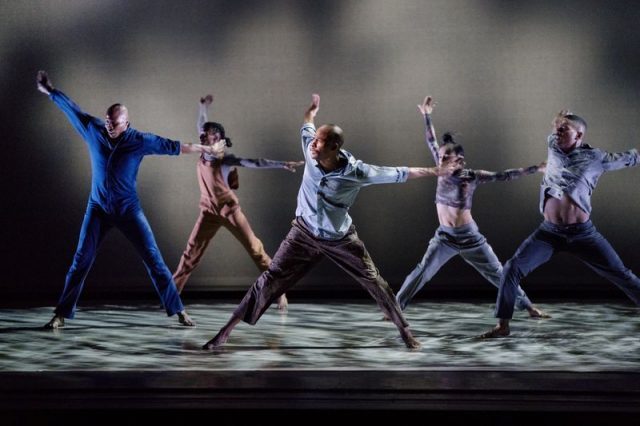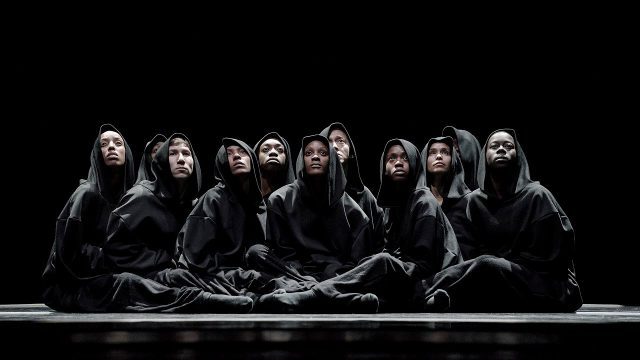
Donald Byrd’s Greenwood looks at 1921 Tulsa Race Massacre (photo by Paul Kolnik)
ALVIN AILEY AMERICAN DANCE THEATER
New York City Center
130 West 56th St. between Sixth & Seventh Aves.
Through January 5, $29-$159
212-581-1212
www.alvinailey.org
www.nycitycenter.org
Alvin Ailey American Dance Theater’s monthlong 2019–20 annual winter season at City Center is titled “Ailey Revealed,” offering a potpourri of works that celebrate the company’s past, present, and future. Every year I attend one of the “All New” programs, and the one I saw on December 20 was, pun intended, a revelation. The evening began with choreographer Donald Byrd’s fifth work for the company, Greenwood, a stirring interpretation of the 1921 Tulsa Race Massacre, which is also the starting point of the sensational HBO series Watchmen. In the late spring of 1921, there was some kind of incident between white elevator operator Sarah Page (danced here by Danica Paulos) and black shoeshiner Dick Rowland (Chalvar Monteiro), a pair of teenagers who might have known each other and even had a relationship. For still unknown reasons, she screamed and he was arrested, imprisoned, and nearly lynched. When the black community marched to the jail to protest, the white community, already uneasy at the success of black businesses in Tulsa’s Greenwood district, known as “Black Wall Street,” used the situation as an excuse to rampage through the district, kill hundreds of black citizens, and destroy millions of dollars’ worth of property.
Set to original compositions by Israeli ambient music composer Emmanuel Witzthum (joined on two pieces by British musician Craig Tattersall) as well as two southern black folk songs, Greenwood is a fierce and powerful thirty-five-minute work. The elevator scene is repeated slightly differently several times, as if in differing recollections and retellings, each followed by Monteiro trying to escape (running in place) as two black couples, Clifton Brown and Jacquelin Harris and Solomon Dumas and Ghrai DeVore-Stokes, react alongside them and Ku Klux Klan members wreak havoc. The three couples are in conventional 1920s attire, the men in suits, the women in brightly colored long dresses, while the Klan (Jeroboam Bozeman, Patrick Coker, Samantha Figgins, James Gilmer, Michael Jackson Jr., Yannick Lebrun, and Miranda Quinn) is dressed in silver outfits and masks. (The superb costumes are by Doris Black; Watchmen fans are likely to think of “Mirror Guy” from the cable show.) Throughout the piece, Courtney Celeste Spears, in more traditional African apparel, walks slowly around the stage, solemnly bearing witness to the tragedy. A long opening in the back serves as an entrance and exit, Jack Mehler’s lighting changing colors as smoke emerges, as if hell awaits. Byrd refers to his recent work as a kind of “theater of disruption”; Greenwood more than captures that philosophy.

Camille A. Brown’s City of Rain is a tribute to a lost friend (photo by Paul Kolnik)
Following intermission is a new production of Lar Lubovitch’s sensual 1990 duet Fandango. The seventeen-minute work is performed by Paulos and Brown to Ravel’s “Bolero,” both in black costumes. They longingly explore each other’s body, much of the time moving on the floor. It’s like a sweet palette cleanser after the brute force of Greenwood and a tender lead-in to the company premiere of Camille A. Brown’s City of Rain, a reimagined version of the Tony winner’s 2010 work about the loss of her friend Greg “Blyes” Boomer, who died of a paralyzing illness the previous year.
Set to Jonathan Melville Pratt’s “Two Way Dream” for strings, percussion, voice, synthesizers, and laptop, City of Rain features ten dancers (Jeroboam Bozeman, Patrick Coker, Solomon Dumas, Jacquelin Harris, Yannick Lebrun, Danica Paulos, Belén Indhira Pereyra, Miranda Quinn, Jessica Amber Pinkett, and Courtney Celeste Spears) moving in unison, rolling around on the floor, breaking off into smaller groups, and reaching toward the sky for seventeen minutes, in costumes by Mayte Natalio and with lighting by Burke Wilmore. Brown (The Groove to Nobody’s Business, The Evolution of a Secured Feminine) melds different styles in the emotionally gripping piece.

Aszure Barton’s BUSK is reimagined for Alvin Ailey (photo by Paul Kolnik)
The evening concludes in a big way with the company premiere of Aszure Barton’s 2009 BUSK, in which the daring Canadian-born choreographer explores what she calls the “multitasking [and] the wisdom of the body.” Updated for this presentation and staged by Jonathan Alsberry, BUSK, which is named for the Spanish word “buscar,” meaning “to look for, is performed by thirteen dancers dressed in dark monks’ robes with hoods, designed by Michelle Jank. Nicole Pearce’s lighting and set includes a small stoop and a disco ball. The spectacular piece is packed with stunning moments and punctuated with surprise and delight: The dancers occasionally make funny faces, sit in a center circle and bow their heads, and wave white-gloved hands. A soloist has fun with a hat. An impressive chest is bared. The score consists of eight wide-ranging songs, by Camille Saint-Saëns, Moondog, Daniel Belanger, and others, that add to the unpredictability of the twenty-minute work. Barton’s previous Ailey piece was 2013’s Lift. Let’s hope it’s not another six years before the next one.
The City Center season, which wishes a fond farewell to longtime dancer and associate artistic director Masazumi Chaya, who has been with the company since 1970, continues through January 5. There will be all-new programs on December 28, January 1, and January 4 (with a mix from the above as well as a new production of Judith Jamison’s Divining and/or the world premiere of Jamar Roberts’s Ode). In addition, “Ailey Classics” takes place December 28 and January 3, “3 Visionaries” on December 24, and the season finale on January 5.